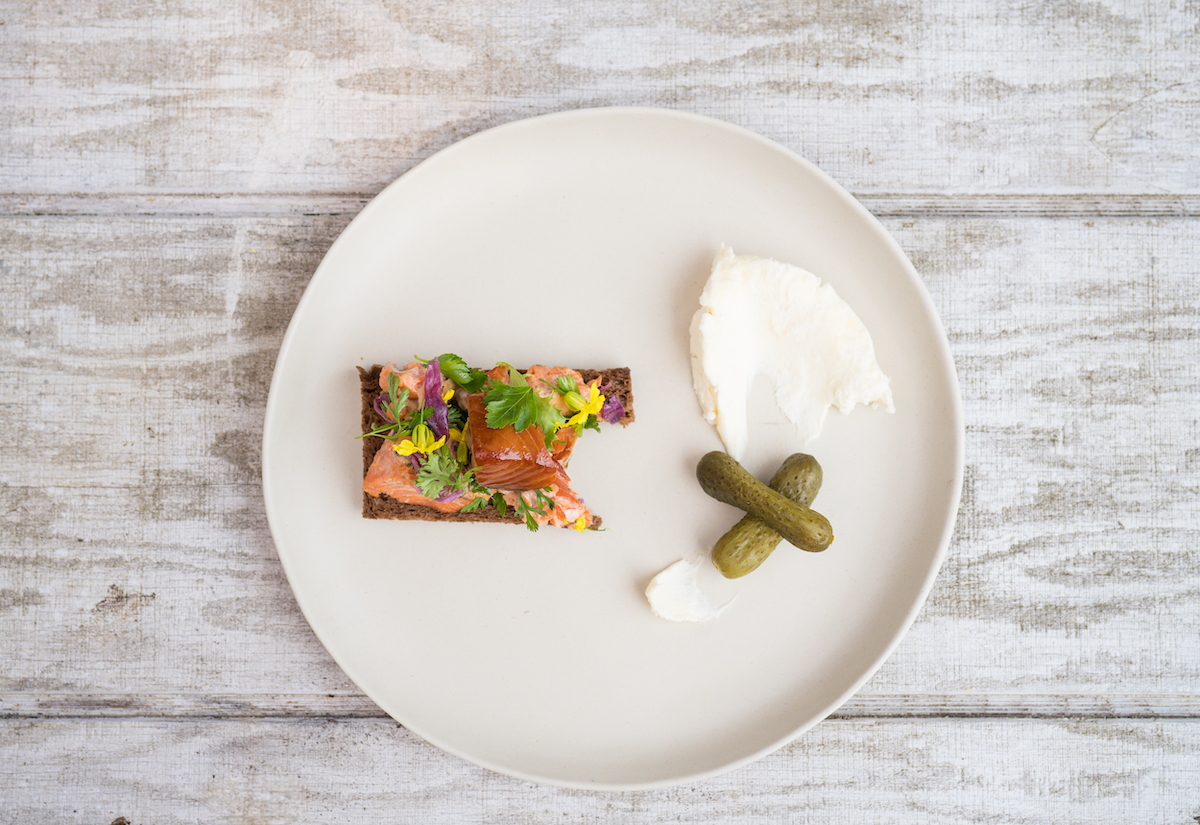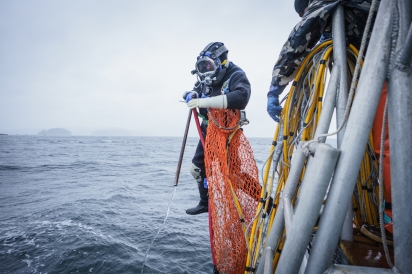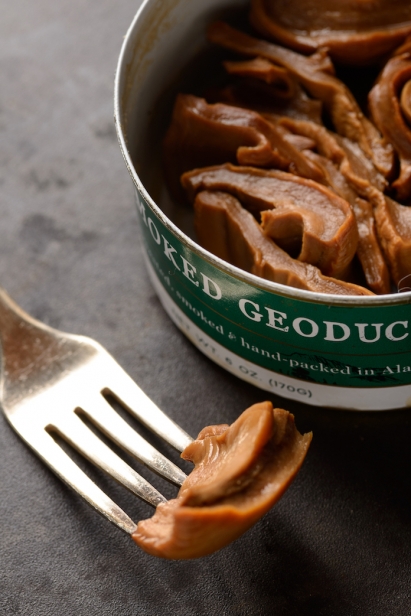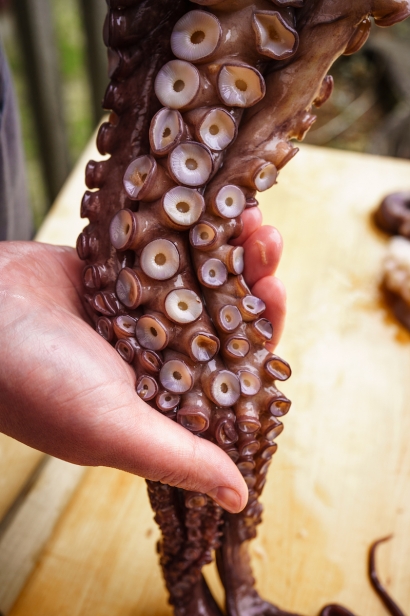Geoducks & Other (Delicious) Alaskan Curiosities
Get your giggles out now, because the people in this story are pretty serious about geoducks. This peculiar mollusk, whose undulating breast meat and brontosaurus neck are too enormous for its shell to contain, has an appearance that could make even Stormy Daniels blush. It’s pronounced “gooey-duck” and, while its name and physique aren’t particularly helpful in the marketing department, these bivalves sell. For some, they are a coveted delicacy. Between 90- 95% of Alaska’s geoducks are exported alive to Asian markets, where, their silky flesh is prized for sushi and other culinary feats. Very little “value-add” processing happens to geoducks in state. This means that geoduck isn’t turned into a product like a fillet or a burger that requires further handling. It also means less money and fewer jobs circulating locally through its harvest. A growing number of divers and businesses, however, are working to ensure that a portion of wild geoducks and other under-recognized seafoods spend more time in Alaskan hands and mouths.
Diving for Geoduck
Meet Curtis Brown. Don’t let his soft smile and kind disposition fool you. He is a seasoned geoduck hustler on the Klawock dive scene. His military roots are apparent in the attention and care he brings to his craft. He is patient, careful, and deliberate, which is important when you are weighed down 50 feet in frigid waters. “Geoducks like the sugar sand,” he says. “The barnacly-broken up- shell sand that when you toss it up, it’ll all settle down. That’s where you’ll find them.” Curtis slaps on his fishing costume — a dry suit and layers of fleece — with precision. He spits into his mask, rubbing the glass clear before falling gracefully into the drink.
The name geoduck originates from the Nisqually Native American phrase for “dig deep.” These mud-loving mollusks are the largest burrowing bivalves on the planet. Their double barreled necks alone can reach four feet in length and stretch skyward till they peek out of the sand like some strange underwater garden. They can live this way for a century and are found up the coast from Baja California to Southern Alaska. Geoduck farms in Washington State are a multimillion dollar industry. The Alaska Department of Fish and Game manages the state’s small wild geoduck fishery in Sitka, Ketchikan, and Prince of Wales.
It’s blowing 30 knots and spitting rain. The forested islands play peekaboo behind the swell and into the mist. The hull climbs and dips. Below the sea, it’s turbid. These are the conditions, according to Curtis, that divide the seasoned divers from the newbies. He calls it “fishing by braille.” Below the murky surface, in his underwater space suit, he feels for the presence of craters in the sand, plunges one hand in, grips the unsuspecting bivalve by the neck, and then uses his hose to pressure blast the sand away. “When you get to the point where you can see and feel geoducks that nobody else can because you have been doing it so long, that’s what makes a good diver,” says Curtis. On the surface, the umbilical cord that connects Curtis to lifegiving oxygen uncoils like an exaggerated trachea. When his purse is full, onboard crew member Ryan Jones hauls the bounty up from the depths. The net is bulging with the strange mollusks, their ridiculous wrinkled proboscises leaking in all directions.
Pay careful attention to the next step, which happens in a flash: Ryan grabs the unbroken geoducks and slaps elastic bands across their intact shells. This is the full extent of “value-add” that most geoducks see in Alaska. He sets the broken geoducks aside. They fetch a low price because they will not survive the journey to Asia alive.
Wildfish Cannery
Enter Wildfish Cannery, Klawock’s smoking and canning seafood company. Wildfish is creating new opportunities for those discarded clams by turning them into award-winning smoked and canned geoduck. “One of our missions at Wildfish is to find underutilized resources in Alaska, whether it’s cracked geoducks or octopus bycatch being used as bait, and bring those products to U.S. shelves, and get more value out of them for the fishermen,” says Mathew Scaletta, owner of Wildfish.
Scaletta has fluffy dark hair peppered with silver, and an eclectic mix of colorful tattoos that peek out of his chef coat. On his upper arm, a kitty flies an alien spaceship beaming up a pizza slice and a fried chicken drumstick. He is serious about this business, however, and serious about food — although most conversations are punctuated with eruptions of contagious laughter. Also, Scaletta can’t eat the geoduck he’s canning. Ironically, he’s allergic to shellfish and slightly bitter about it. “It is still fun, though. Geoduck and octopus are just unusual and cool and it is fun to work with these interesting creatures.”
A 50 lb. block of octopus, shaped by the tote it was frozen in, thaws on the counter. Wildfish sources octopus from the pot-cod fisheries of Dutch Harbor. It is by-catch, not targeted as a commercial species and typically sold for a low price as bait. “Bait!” cusses Scaletta. “That is absolutely insane to me.”
The binding ice starts to calve and the sea monster’s tentacles unfurl. Scaletta blends up a curing mixture. They have spent the past two months testing and tasting smoked octopus recipes. “We like to say that octopus is ‘crafty in life, craftier in death’,” says Scaletta. “It’s culinarily challenging to scale octopus processing to our standards.
We cycle through test batches, try different cures, cutting methods, explore how long to smoke, how much smoke, how much heat, how long to can and at what temperature,” rattles off Scaletta.
Mastering their smoked octopus recipe has taken care, mishaps, and time. And geoduck isn’t much easier. “Geoduck is hard,” he laughs. “Because you have to get all the sand out of it. It’s physically demanding and takes a lot of man hours to produce. We are doing all of this by hand because we don’t have cool machines to do it for us.”
Elevating Alaska’s Home-Grown Traditions
Scaletta inherited Wildfish Cannery from his grandmother, Phyllis Mueller, who over her 28-year tenure perfected the smoking process. She focused on salmon and other local fish, building an impressive and loyal following among commercial fishermen, visiting anglers, and community members. She smoked geoduck on a small scale for divers and fishermen, but she rarely direct-marketed her products. Mathew’s father, Greg Scaletta, helped expand Phyllis’ smokery, lending his focus and impeccable attention to detail to the canning process. “With canning, you’re dealing with this food product that can kill people, terribly, if it’s not created to these very, very exact specifications. It’s nothing you mess around with,” says Scaletta. “The cannery part of Wildfish Cannery wouldn’t exist without my dad.”
When Mathew took over the reins in 2016, he infused his grandma’s smoke and father’s technique with his own global experiences and culinary background as a cook in fine restaurants. “Whereas canning in Alaska has always been about producing a commodity product and using low grade fish … canneries in Spain and northern France are doing a smaller scale, high quality product with attention to detail. And when you open one of those cans it’s something that looks nice, there is care done and its considered a gourmet item. Whereas a traditional can of pink salmon isn’t terrible, it’s a simple product, but it’s not something you get really excited about.”
That’s right. This isn’t your grandma’s industrially-produced can of pink salmon slush. This is Mathew’s grandmother’s can of delicately smoked white king salmon. Interest in this type of high-quality canned seafood is growing in the U.S. “Tinned seafood is becoming a trendy thing in urban settings. You can go into a very, very nice restaurant in major cities and you’ll find a menu with fine wines and canned seafood.
All that seafood is coming from Europe and not Alaska, which has a tradition of canning and great seafood. There’s no reason we can’t be filling some of that market. We have some of the best seafood on the planet here,” says Scaletta.
Of course, canning seafood with care and quality is not new to Alaska. “We have these skills and affinity already because of the home canning tradition. So, it’s not about importing European style, it’s about elevating our home-grown culture of preserving foods,” says Scaletta.
Ethical Food Businesses in Rural Alaska
Rural Alaska’s belly rumbles for economic opportunity and because of that home-grown canning culture, Scaletta is proud of the jobs Wildfish cooks up. Klawock is a small town of nearly 800 year-round residents and Wildfish employs between 7-14 people. Scaletta is hoping to stretch employment into the shoulder seasons by exploring opportunities with oysters, geoduck and octopus — seafoods that can be frozen and processed in the off-season with no impact on quality.
“Having jobs in this small community is important, especially when those jobs align with the values people have at home. Everyone here also works with seafood in their own time, putting up food for themselves. This work becomes an extension of that. Locals have pride in smoking seafood and doing something that has meaning [and] creates value in itself,” says Scaletta.
Cracking open a tin of smoked geoduck reveals a deep, rich, almost sultry flavor. Each piece is a uniquely twisting, smoke-seasoned shape, soaking in a delicious juice. It’s hard to believe that the offensive looking creatures Curtis was uprooting from the seafloor could evoke such class. What’s next? In addition to their lineup of smoked salmon and geoduck, Wildfish will launch smoked octopus at this season’s end Juneau Public Market. And oysters are after that.
At Wildfish, good taste radiates off the plate. In addition to adding value to broken and bycatch fisheries, the company supports the local community through donations to the local tribe and senior center.
“Being a responsible community member is fundamental for local businesses… Alaska has a problem, as everyone knows, with resource extraction [by] companies coming in with no long term vision, taking fish en masse out of the ocean or trees off the landscape, leaving and taking the value with them,” says Scaletta. “That way of doing things is not working anymore. Well, it never worked, at least not for everybody. Part of the healing from that, involves companies being more aware and more conscious of their place in the whole ecosystem of Southeast, the community, and the environment,” says Scaletta.
Wildfish joins a growing number of Alaskan entrepreneurs who are working creatively to infuse social and environmental responsibility with our delectable natural resources. And those are ideals that many Alaskans will happily consume — even if they start out as odd undersea creatures with uncomfortable shapes.









